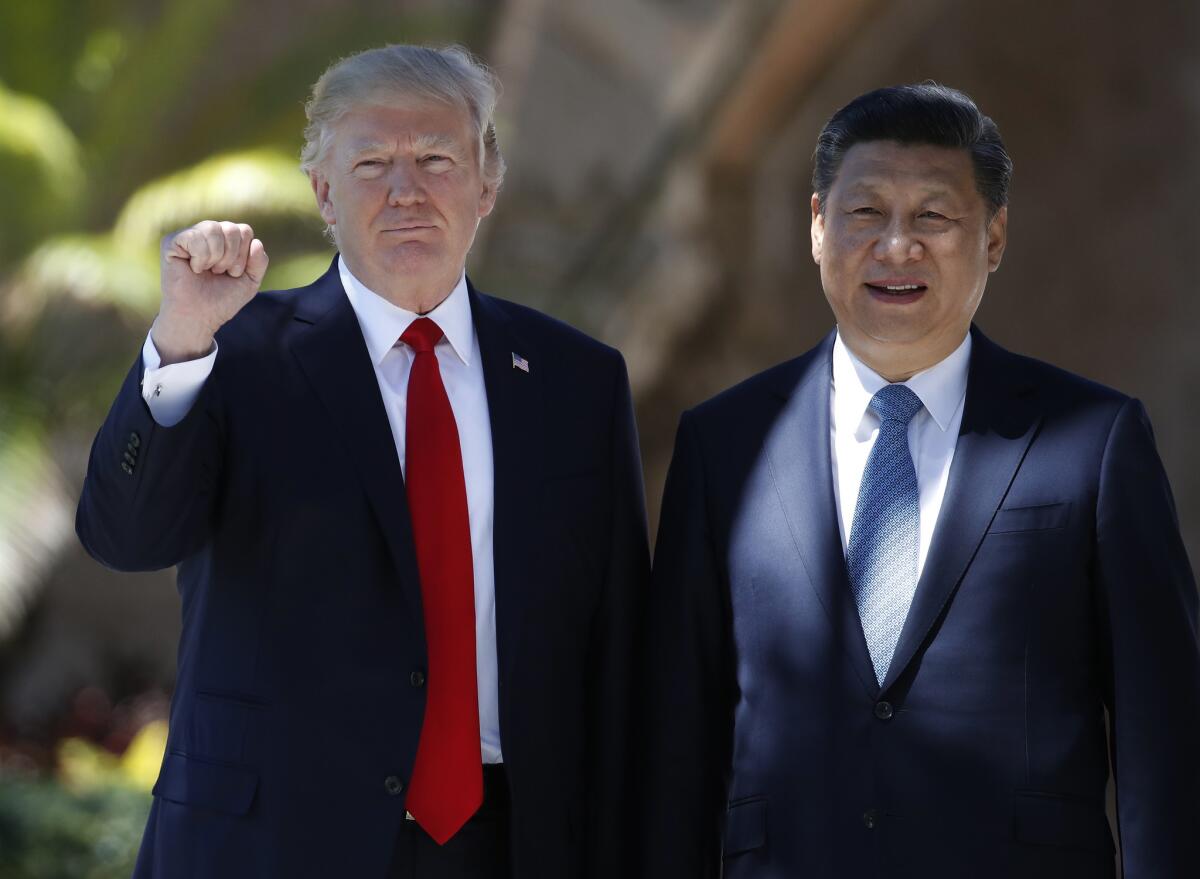Trump imposes new 10% tariff on Chinese goods as trade talks stall

- Share via
WASHINGTON — Barely one month after agreeing to a ceasefire in his trade war with China, President Trump on Thursday loaded up the tariffs again in a surprise announcement that he would slap 10% duties on an additional $300 billion worth of Chinese goods starting Sept. 1.
In a series of tweets, Trump suggested he was taking the step in response to the slow-moving trade negotiations, which resumed this week, and China’s lack of action. He accused President Xi Jinping of not following through on agreements to purchase American farm products and to end the sale of the opioid drug fentanyl to the United States.
“I think he wants to make a deal but frankly he’s not going fast enough,” Trump said of Xi, speaking to reporters on the White House South Lawn later Thursday.
The threat of renewed escalation of tariffs comes as the Federal Reserve and many economists have become increasingly concerned that trade tensions are undermining business confidence and could do serious damage to the American economy. If Trump carries out his threat, retail executives say, U.S. consumers will end up footing a good chunk of the tariff bill in the form of higher prices, likely right before Christmas.
Prior rounds of tariffs involved many machinery and components from China, but the new 10% tariffs would hit a host of consumer goods — cellphones, computers, shoes and apparel.
“Go into a Target, look under a Walmart roof, it’s everything,” said Matt Priest, president of the Footwear Distributors and Retailers of America. Shoe importers had not been caught in previous rounds of tariffs, but would not escape the upcoming one. Nearly 70% of footwear that Americans buy are imported from China, he said.
In part because of such concerns stemming from trade uncertainties, the Fed on Wednesday made its first interest rate cut in more than a decade. “Weak global growth and trade tensions are having an effect on the U.S. economy,” Fed Chair Jerome H. Powell said Wednesday. “You see weak investment. You see weak manufacturing.”
Moments after the president’s tweets, the Dow Jones Industrial Average erased all of its 300-point gain and ended the day down by a similar amount, a swing of about 600 points.
The trade war with China has been going on for a year and a half, with off-and-on talks and several rounds of tit-for-tat tariffs between the world’s two largest economies.
After a breakdown of negotiations in May, Trump ratcheted up tariffs to 25% from 10% on $200 billion of imports from China, and he threatened to hit the remaining $300 billion Chinese goods with duties. (Trump earlier last year imposed 25% duties on $50 billion of Chinese merchandise.)
Come September, Trump will have slapped punitive tariffs on virtually all Chinese imports coming into America.
U.S. business groups, while accustomed to Trump’s unpredictability and fondness for tariffs as a pressure tactic, were nonetheless dismayed by the new tariff announcement.
A month ago, after meeting with Xi at the Group of 20 economic summit in Japan, Trump announced that he would hold off on more tariffs while the two sides restarted talks. Earlier this week, senior U.S. and Chinese trade officials met in Shanghai, and according to a White House statement issued Wednesday, the conversations were “constructive,” and China reportedly has renewed its vow to increase purchases of United States agricultural exports.
“We thought we had a ceasefire, they were still negotiating, and now for this to come out, it’s very concerning,” Priest said.
Trump himself described the new 10% duty as a “small additional tariff” in his tweet, and later reacted nonchalantly about the market dip, saying that he “expected” it. Trump continued to insist that the U.S. is raking in cash as a result of the tariff, with China paying. But experts overwhelmingly agree that’s not the case, as American consumers and businesses bear the brunt of the cost.
“Raising tariffs by 10% on an additional $300 billion of imports from China will only inflict greater pain on American businesses, farmers, workers and consumers, and undermine an otherwise strong U.S. economy,” said Myron Brilliant, head of international affairs at the U.S. Chamber of Commerce.
Trump, as he has for months, expressed optimism Thursday about an eventual deal with Xi. “We look forward to continuing our positive dialogue with China on a comprehensive Trade Deal, and feel that the future between our two countries will be a very bright one!” Trump said in a tweet.
But analysts and business groups worried that throwing new tariffs on China would have the opposite effect and drive them away from the bargaining table and prompt retaliatory actions from Beijing.
China has slapped counter-tariffs each time, but last year imported only $120 billion of American products, compared with $540 billion that the U.S. buys from China.
“China does not import enough to respond in kind, so any retaliation will be qualitative and disproportionately impact U.S. companies operating in China,” said Craig Allen, president of the U.S.-China Business Council. “We are particularly concerned about increased regulatory scrutiny, delays in licenses and approvals, and discrimination against U.S. companies in government procurement tenders.”
Trump, in other public comments in recent days, has suggested that China is reluctant to make a deal before the 2020 election in the hope that he may lose and that a Democratic president would give them more beneficial terms as part of a trade agreement.
China experts say Beijing wouldn’t necessarily be holding out for a Democrat in the White House, given that there is bipartisan support among presidential candidates as well as in Congress to get tough on China. At the same time, they say, Chinese leaders would probably welcome dealing with another president and administration.
“I think they’ve decided [Trump’s] unreliable,” said Nicholas Lardy, a China economy specialist at the Peterson Institute for International Economics. Initially, he said, “they thought that this guy wants to make a deal, and we know how to deal and can reach an agreement, some compromise on each side. But I think their view is that Trump has changed the terms of what he’s asking for repeatedly, and he’s unpredictable.”
American officials, however, have lodged similar complaints, that Beijing had reneged on commitments it made during negotiations.
While Trump has often talked about wanting China to buy more U.S. goods to reduce the trade deficit, his negotiators have been pressing China to make fundamental changes in its state-run economy that would open up markets to American firms and protect their intellectual property.
In recent weeks, analysts have become more pessimistic that the two sides can reach a substantive and sustainable deal, especially in the wake of Trump’s blacklisting of the Chinese telecom firm Huawei. A month ago in Japan, Trump said he would allow U.S. suppliers to export parts to Huawei, but there have been no details yet on what that means.
Analysts say that Beijing has drawn a line in the trade talks, demanding that tariffs be lifted and restrictions on Huawei removed. They also want changes made by China to be undertaken by administrative regulations, not codified in national law, as the U.S. side has insisted.
More to Read
Inside the business of entertainment
The Wide Shot brings you news, analysis and insights on everything from streaming wars to production — and what it all means for the future.
You may occasionally receive promotional content from the Los Angeles Times.











